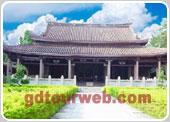1) Confucianism and imperial examinations


儒学科举
1.
Because there were many differences between the reasons for doing business, local cultures, power of the families and relations with the feudal governments, Shanxi merchants and Huizhou merchants of Ming and Qing Dynasties had different attitudes toward Confucianism and imperial examinations.
由于促使晋商、徽商从商的原因不同,徽商与晋商所处的文化氛围不同,宗族势力强弱不同以及与封建政治势力结合的紧密程度不同,在对待儒学科举的态度上,晋商和徽商也有很大区别。
2.
It came from comparing the differences between two commercial groups:the difference of treating confuciannism and imperial examinations, the difference of getting accomplishment of Confucianism and imperial examinations.
本文从晋商与徽商对待儒学科举态度上的差异以及晋商与徽商所取得的儒学科举成果的差异两个方面,进行了多角度的比较,得出了晋商重商轻儒,而徽商则“贾而好儒”的各自特色。
3) YUAN-MING: supervisor of Confucian School


儒学提举
4) study of imperial examination


科举学
1.
With its academic quality of seeking truths and its open disciplinary system,the study of imperial examination(IE) continues to provide us with enlightenment and reference in our efforts to preserve history,discover laws of cognition,and interpret cultural phenomena.
科举学以其求真的学术品格、开放的学科体系,在保存历史、认知规律和阐释文化中,给人以新的启迪与借鉴。
2.
And the condition for the "study of imperial examination" to become a science discipline is getting ready.
国内科举制研究在1921—2007年近86年里,经过长期跋涉逐渐走向繁荣,科举研究成果蔚为大观,"科举学"作为一门学科的条件也日趋成熟。
3.
Pursuits of truth is the motive power to impel the study of imperial examination to become a discipline.
求真是科举研究超升为科举学的原始驱动力,也是年轻的科举学逐步走向成熟必须坚守的品格。
5) the study of imperial examination


科举学
1.
In the ancient times,"the study of imperial examination"(Kejuxue) referred to the way and methods on how to prepare the imperial examination.
古代"科举学"是指备考科举之学,现代"科举学"是指研究科举之学。
2.
The disciplinary attribute of the study of Imperial Examination is a focus of recent academic attention.
科举学研究性质之争是近几年学界关注的焦点之一。
6) Scientific Behaviors


科学举措
补充资料:海阳县儒学宫

海阳县儒学宫
海阳县儒学宫位于潮州城区昌黎路和文星路交界处。俗称红学、学宫。始建于南宋绍兴年间,景炎三年(1278),后毁于火。明洪武二年(1369)重建大成殿,虽历经沧桑,其主要建筑大成殿仍完整地保留了明初粤东地区殿堂建筑的风貌特点,以后历代屡有增建,始成规模宏大的建筑群。
殿中供孔子及其弟子塑像。宫内现存大成殿、泮池、棂星门、照壁等建筑,只占原来面积的三分之一。其大成殿保留着明代的宫殿式建筑风格,抬梁式屋架由43支大柱支撑,殿周有石栏杆围护。近年来曾重修棂星门、金声门、玉振门和泮池,并嵌有明、清维修学宫碑记6块。学宫是重要的革命纪念地,国民革命军二次东征时的东征军第一师政治部和南昌起义军军官教导团均曾驻扎于此。学宫现为潮州市博物馆馆址。
说明:补充资料仅用于学习参考,请勿用于其它任何用途。